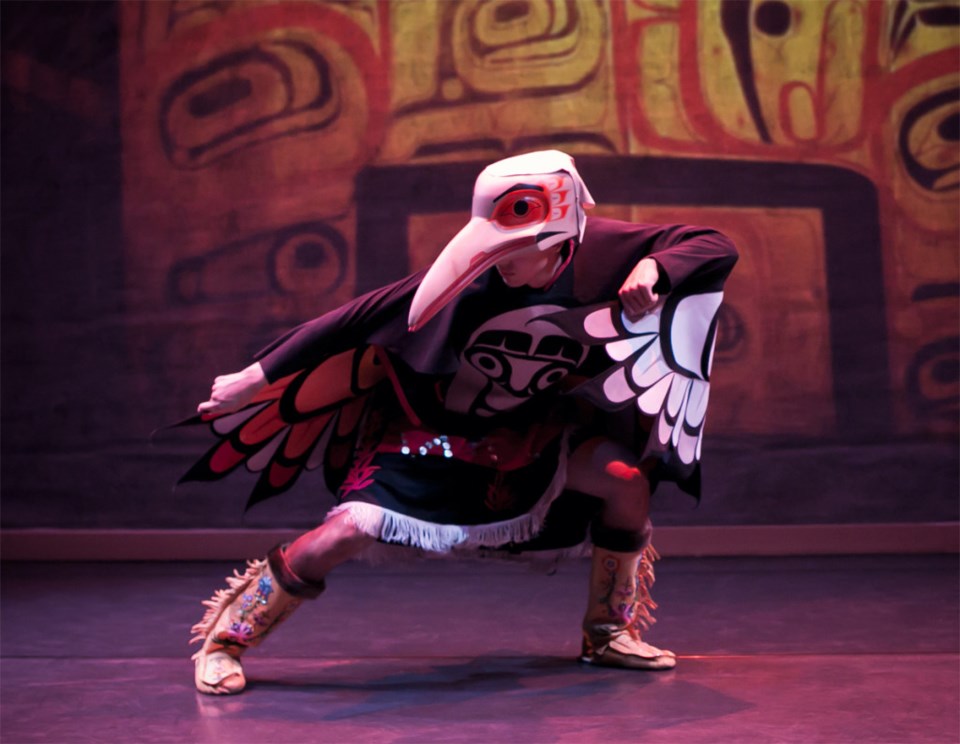There was a time, not so long ago, where every step of a Gitxsan dance ceremony was a step away from extinction.
For 67 years, the potlatch ceremonies of the Pacific Northwest were banned in Canada, and collective acts such as feasting, gift giving, and dancing were treated as imprisonable offences.
So, when the ban was finally lifted in 1951, every subsequent ceremony became an act of preservation, every single gesture and movement needed to be accurate, needed to be authentic, to wrest ancestral traditions from the clutches of colonial repression and pass them down to the next generation.
It was amidst that era that Margaret Grenier began learning coastal dance. Grenier is now the leader and artistic director of the Dancers of Damelahamid – the Gitxsan dance company her parents, Ken and Margaret Harris, founded five decades ago to help restore their cultural traditions – and attributes her love of the art form to her parents.
“The reason why I’ve worked with the Dancers of Damelahamid is it’s something that was in many ways passed down to me from my parents,” the soft-spoken dancer, who took over the company in 2002, explains. “And they did several decades of work, starting in the 1960s, which followed the potlatch ban being lifted. And at that time the focus was really in revitalization and bringing practices back to communities.”
Her parents also launched Prince Rupert’s long-running Haw yah hawni nah Festival, which brought together dancers from throughout the Northwest Coast in an annual public celebration, and is credited as having played a significant role in British Columbia’s First Nations dance revival.
Not content to carry on in only a preservationist capacity, however, Grenier, who also serves as artistic director of the Coastal First Nations Dance Festival, has slowly and subtly taken things further – expanding the accessibility of the company’s public programming, while subconsciously incorporating her own experiences (with contemporary dance companies like Karen Jamieson Dance, for example) into her choreography.
“At the time, several decades ago, there really was a strong need [to] focus on tradition and to look at how things have been practised,” says Grenier. “But there’s also a need for that practice to be open to influences that are taking place within each generation,” she explains. “In some ways, for myself, it’s really to take the work that [my parents] did and move it forward.”
Flicker, premiering May 25-29 at The Cultch, is the Dancers of Damelahamid’s most avant garde blend of coastal dance and contemporary influences yet. Building on ideas explored in their 2013 signature work, Spirit Transforming, which stripped the Gitxsan masked dances down to their most minimalistic elements, Flicker delves even deeper into what makes Gitxsan dance unique, while fearlessly innovating within the form.
“I feel like Flicker is [the product of ] what we learned from that process of stripping down to the essence of asking ourselves these questions,” says Grenier. “What it is that makes this form distinct, and what do we carry forward in that way.”
At the onset of Flicker, the audience is enticed as though stepping into a story. Then, the titular “flicker,” or woodpecker, of the piece’s name, leads a young man to a river to perform a cleansing ritual for the journey ahead.
Combining live-action shadow dance, powwow, coastal dance, contemporary indigenous dance, multi-media projections, and West Coast graphic design, Flicker is a rich spirit world brought to life. The bird at the heart of the story was chosen to represent duality, and as masked dancers journey across the piece’s mystical, shimmering landscapes, they use the cloak of the flicker to move in and out of the realm of their ancestors.
“I think that in many ways [Flicker] is an exploration of new ideas,” says Grenier. “And then also, even in all these different aspects – the choreography, the regalia, the music – I think that this piece really ties into [...] the idea that our identities as indigenous people are complex, and we’re influenced by many different things.”
For Grenier, placing Flicker in conversation with mainstream contemporary dance marks an exciting, ongoing shift in the very definition of what contemporary dance is.
“What I feel like what is happening is there is [...] a broadening in terms of what is defining itself as contemporary dance,” she explains. “So rather than it being a set of two different forms coming together, seeing if you can take a little bit of one thing and a little bit of another, it’s the sort of redefining of contemporary dance [to not] necessarily mean [only] one form of dance background.”
While pieces like Flicker are created to be intellectual and spiritual conversation with contemporary audiences, though, Grenier says that the dancing itself has always had – and will always have – a deeper purpose.
“We have a fairly recent colonial history in BC and there is a lot of brokenness in communities. There’s a lot of poverty,” Grenier says, quietly. “I grew up in the north and I know not just the poverty of it, but also the spiritual and cultural poverty that goes with that. So by practising dance and art, I think that feeds something that you couldn’t otherwise. And also helps me to process in a healthy way all of these things, and hopefully transform them and share that.”
• Dancers of Damelahamid’s production of Flicker runs May 25-29 at the Historic Theatre at The Cultch (1895 Venables). Tickets from $20; Tickets.thecultch.com


